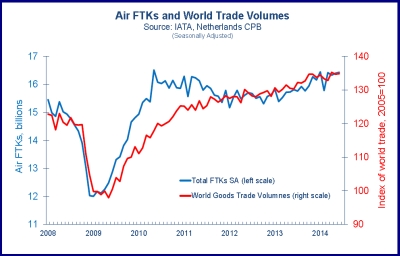
IATA reports that air freight volumes were up by a strong 5.8% in July compared to a year ago. This is an acceleration on June, when freight tonne kilometres rose 2.4%, and reflects improving demand conditions in some regions.
There was also a strong expansion in volumes in July compared to June of 1.1%. In fact, it appears that demand conditions in some parts of the world are now starting to improve again, after a pause in earlier months this year, with July FTK levels finally exceeding the post-crisis peak in mid-2010.
The performance of air freight markets has closely followed developments in world trade and business activity, which both showed solid gains toward the end of 2013, only to taper off earlier this year. Most recent data, however, suggests that there has been a resumption in prior improvements in some regions.
The most notable improvement over recent months has been for the Asia Pacific region. Carriers in this region have experienced a 7.1% rise in freight tonne kilometres (FTK) in July year-on-year. Emerging Asia trade volumes have now recovered after decline throughout Q1, with a solid expansion in volumes in June.
By contrast, airlines in Europe have seen little improvement in air freight demand over recent months. Local carriers experienced a 1.8% increase in FTK in July compared to a year ago, the weakest rate of growth among regions. Whilst industrial production measures over recent months have pointed to accelerating growth in the Eurozone, the Russia-Ukraine crisis and ensuing EU sanctions have resulted in downward pressure on growth momentum in the region, particularly for nations like Germany with significant exposure to Russian industries.
Load factors increased by a solid 0.6% in July compared to June, helped both by the rise in volumes and contraction in capacity. Load factors are also improved on a year ago in all regions except Europe.
The outlook for air freight markets remains broadly positive. Trade volumes in Emerging Asia have fully rebounded from weakness in Q1, and the Chinese government stimulus earlier in the year is now starting to have positive impacts on that economy. Global business conditions remain positive, even though further improvement has been limited by weakness in some part of the Eurozone. And although new exports orders have been volatile over recent months, levels still indicate growth in world trade, which bodes well for air freight demand.
Asia Pacific leads the way
The most notable improvement over recent months has been for the Asia Pacific region. Carriers in this region have experienced a 7.1% rise in FTK in July year-on-year. Emerging Asia trade volumes have now recovered after decline throughout Q1, with a solid expansion in volumes in June. After a slow start to the year, the Chinese economy has been stabilising over recent months. GDP growth reached 7.5% year on year in Q2, picking up from 7.4% in Q1, suggesting that modest loosening of fiscal and monetary policy is having positive impacts.
Airlines in other emerging markets also experienced solid growth in July. African airlines recorded the strongest rise in FTK in July, up 11.3% year-on-year, which is a strong acceleration on June, when volumes rose just 2.5%. Latest trade data for Africa shows a rise in volumes, which could in part explain the strong increase in FTK in July compared to a year ago. There is also the issue of high volatility in volumes for this region, which could cause some distortions in the monthly figures. Given that there has been significant slowdown in major economies like South Africa this year, it is too early to conclude acceleration in the growth trend due to this month’s result alone.
FTK carried by Middle Eastern airlines increased 9.4% in July year-on-year. Airlines in the region are capturing opportunities for growth by introducing services to regions of strong and developing trade activity, including Mexico in Central America and Uganda in Africa. The growth rate in July is slightly negatively impacted by the timing of Ramadan, which took place mostly in July 2014, and a month later in the previous year. The holiday tends to suppress demand for air freight.
Airlines in Latin America recorded a strong 7.6% rise in air freight volumes in July year-on-year. Declines in regional trade volumes earlier in the year and continued weakness in economies like Brazil have restricted growth in air freight so far this year, so this result is in stark contrast to the trend seen over recent months. There are signs, however, that prior weakness in regional trade growth is now reversing, with latest data showing a solid month-on-month increase in both imports and exports to/from the region.
Air freight carried by North American airlines increased by a solid 5.2% in July compared to a year ago. The first quarter had seen weakness in trade volumes, potentially impacted by severe weather conditions. Latest data show a rebound in trade volumes and underlying growth trends in business activity are positive, which could provide some support for stronger growth in trade and air freight demand ahead.
By contrast, airlines in Europe have seen little improvement in air freight demand over recent months. Local carriers experienced a 1.8% increase in FTK in July compared to a year ago, the weakest rate of growth among regions. The Russia-Ukraine crisis and ensuing EU sanctions have resulted in downward pressure on growth momentum in the region, particularly for nations like Germany with significant exposure to Russian markets, including high-end capital goods and banking. Performance of other major economies like France and Italy has not been able to offset these developments in Germany.





